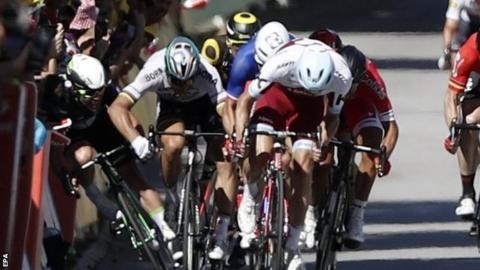Get in touch 0117 325 0526
Get in touch 0117 325 0526
This is the second in my very occasional series of blogs on the overlap between the worlds of professional cycling and employment law.
The Tour de France has recently finished and while I wait for the Vuelta (the tour of Spain) to start I have been reflecting on one incident. It was on Stage 4 (between Mondorf les Bains to Vittel to be precise). In the finishing straight Mark Cavendish made a move to overtake Peter Sagan (who is the world champion and arguably the most popular cyclist in the world today). As Cavendish was drawing level with Sagan, Sagan moved right and appeared to move his elbow towards Cavendish (see the picture). The movement and possibly the elbow caused Cavendish to hit the barriers. As a result Cavendish fell off at about 40 miles an hour which unsurprisingly caused him to break his shoulder and therefore he abandoned the race the next day.

The race jury reviewed the TV footage and 20 minutes after the incident decided to deduct some points from Sagan, but allowed him to stay in the race. Then came the surprise, just over an hour later the jury reviewed its own decision, decided it wasn’t harsh enough and decided to disqualify Sagan from the race. This is where my employment lawyer antennae start to twitch.
The question is what changed? The first, and crucial thing is not the evidence. The evidence is the TV footage, there are about three different camera angles and it is the same footage that the rest of us saw and watched repeatedly and were debating. It’s also not the swirling hysteria that was the reaction to the crash on social media. The jury are isolated from social media we understand. So the question is what or who changed the jury’s mind to increase the sanction so steeply. We do know that the jury was visited by both Sagan and Cavendish’s teams in the intervening period (although interestingly they didn’t interview either rider) and some commentators have pointed out that the main sponsor of Cavendish’s team is also one of the sponsors of the race itself. It wasn’t even really the consequences of the crash that changed as it only became apparent after the decision to disqualify Sagan the true extent of Cavendish’s injury.
We will probably never know why the jury changed their decision so markedly but what we do know for certain is that changing decisions (particularly if they become more severe) does create problems as it creates an impression that an injustice has happened. Sagan’s team appealed against the decision but that appeal was doomed because by the time it was heard another couple of days racing had taken place and to allow him to re-enter the race would have been unprecedented.
We see situations and there are reported cases about managers changing their minds, or having them changed for them, and they rarely end well for employers. This all casts into sharp focus what a Tribunal will be looking at, they want to know what was in the decision maker’s mind when they arrived at their decision. When I am taking a disciplinary manager’s witness statement it’s the question I keep asking, what was the process you followed, to whom did you speak and what was your thought process.
We sometimes see managers who have delegated much if not all of the decision making process to a HR representative or have allowed themselves to be persuaded by a colleague (usually someone more senior) to change their mind. The key thing to appreciate is that it almost certainly won’t be the HR representative or that senior colleague who is sat at the Tribunal witness desk. This means that when you are deciding who should hear a disciplinary hearing, that may result in dismissal, you should choose someone who has the training and gravitas to be able and prepared to make their own decision and to “own” that decision and not to be swayed.
Simon Martin
Partner, Solicitor
email Simon or call 0117 325 0929
Tags: Decision making, Disciplinaries
Categories: Employment Law

5.0/5